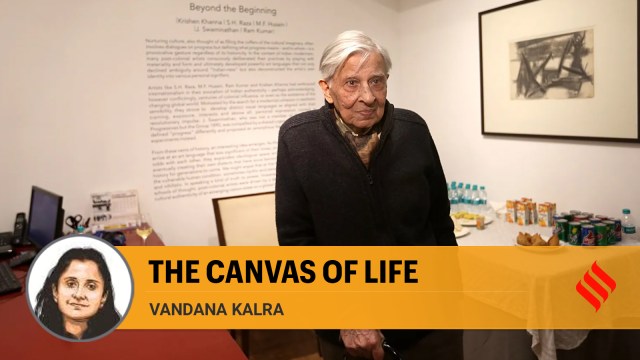
Modernist Krishen Khanna’s foray into the mainstream art circuit was serendipitous. His wife was aboard a ship when she came across an acquaintance who knew the artist S B Palsikar. She wrote him a letter requesting him to see Khanna’s work. Soon, Palsikar arrived at his studio. Impressed by what he saw, he carried back a small canvas depicting a group of people reading the newspaper after Mahatma Gandhi’s assassination. News of Gandhiji’s Death, the 1948 canvas, was featured at Bombay Art Society’s Golden Jubilee Exhibition in 1949 alongside works by the influential members of the Progressive Artists’ Group (PAG) that included, among others, M F Husain, S H Raza, F N Souza and K H Ara. Months later, Khanna was inducted into the art collective, forging enduring friendships and embracing their search for a distinct artistic vocabulary for independent India, distinct from the revivalist nationalism of the Bengal School and the colonial academic tradition.
As he turned 99 this month, the sole surviving member of the PAG, Khanna continues to explore new avenues. One of India’s most versatile modernists, his expressionist brushstrokes have captured the changing times — from the harrowing realities of Partition to the predicaments of the marginalised. Drawing from epics such as the Ramayana, Mahabharata, and Biblical stories, he has reflected on human struggles and triumphs.
The events that disrupted his life and uprooted him shaped his artistic trajectory as well. Born in Lyallpur (now Faisalabad, Pakistan) in undivided India, he was 13 when he received the Rudyard Kipling Scholarship to study at the Imperial Service College in Windsor. The upheaval of World War II brought him back to Pakistan, where the trauma of Partition awaited. As his family relocated from Lahore to Shimla, the violence and bloodshed he witnessed left an indelible imprint. Recollections from the period continue to surface in his paintings. If his 1947 oil Refugee Train Late 16 HRS portrays figures uncertain of their fate as they wait to cross the border, in Benediction on the Battlefield, while depicting the moment when the Pandavas pay obeisance to Bhishma before he passes away, Khanna also reflects on the traumas that victory overrides.
He first arrived in Mumbai in 1948 as an employee at Grindlays Bank. The city, which had emerged as a centre for arts, fostered his creative pursuits. Having briefly attended evening classes at the Mayo School of Art, and learnt drawing at artist Sheikh Ahmed’s Studio One in Lahore, he began painting late into the night. Dubbed “banker-painter” by art critic Richard Bartholomew in the ’50s, Khanna continued to manage both professions till 1961, when he quit Grindlays to become a full-time artist. He had the support of his artist-friends. On his last day at work, Husain, V S Gaitonde and Bal Chhabda were waiting for him at the door. They celebrated with tea, followed by dinner. S H Raza hosted a party in Paris.
The ensuing years were financially challenging but creatively fulfilling. Khanna moved to Delhi with his family, where he accepted a monthly stipend to paint for Kumar Art Gallery. While he experimented with mediums, from photography to sculpture, the human condition remained central to his oeuvre. He also travelled. His 1962 trip to the Far East under a Rockefeller fellowship inspired him to produce a series of sumi-e (Japanese ink on rice paper) paintings. Exposure to abstract works of artists such as Mark Rothko during a residency in Washington in 1964 influenced his understanding of the genre.
The letters he exchanged with members of the PAG, spanning various cities and years are now valuable archives not only of their shared past but as documents that capture developments in Indian art. His evocative tribute to their camaraderie includes an interpretation of Leonardo da Vinci’s The Last Supper. In The Last Bite (2005), he portrays his contemporaries — including Akbar Padamsee, Tyeb Mehta, Souza, Bhupen Khakhar and Manjit Bawa — gathered around a Christ-like Husain in a restaurant. The scene is also perhaps symbolic of the origins of Khanna’s artistic pursuits. At seven, his father had introduced him to the da Vinci work with a copy brought back from a trip to Europe. Khanna’s attempt at replicating it had earned him praise, igniting his lifelong passion for art.
vandana.kalra@expressindia.com



